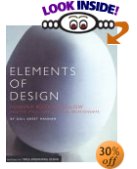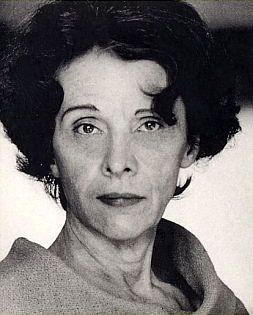Elements of Design
Rowena Reed Kostellow and the Structure of Visual Relationships
by Gail Greet Hannah
 Princeton Architectural Press; New York. Paperback. 158 pages.
Princeton Architectural Press; New York. Paperback. 158 pages.
A review, by Julian Winston, submitted to Amazon.com
I do believe I am somewhat qualified to review this work. After all I was one of Rowena's "boys" in the early 1960s.
Rowena's publicity photo from the back cover of Elements of Design |
The
last time I saw Rowena in 1985 she told me she was working on a book.
At the time, I was teaching three dimensional design at the University
of the Arts in Philadelphia. I too wanted to write a book about three-dimensional
design and had given it a good start. Along the way I realized the impossibility
of writing about dimensional design. It can't be done. It can be approached,
as this present work does. But when you get right down to understanding
the words on the page, they are as slippery in writing as they were with
Rowena in person. I couldn't conceive how she could write it down. It
is not surprising that she did not finish it. Her thoughts were too abstract
to concretize them.
I recall one dialog with her:
"Not quite," she said turning my work. "Just look at it."
"I'm looking, Rowena, "I replied.
"Well look at it some more. You need to get the balance."
The book outlines a series of exercises that Rowena used to develop the ability to see dimensionally. As her student, I did all those exercises, and looking at them in the book and reading the comments of others (many of whom were my classmates) brings back many memories.
The model on which I was working (at the Carl Otto office) when I finally understood what Rowena was talking about. |
I recall how, four years after graduation, I was working in an ID office designing a typewriter, when suddenly it all became clear. I phoned her that evening. "Well, you were a smart kid, Winston. I figured you'd get it."
And then six more years from there, seeing the "convexity" problem that my parents had so proudly displayed in their living room, and realizing that now, at that instant, I saw why she had been disappointed with it. My experiences are echoed by many of those quoted. It is nice to know that I was not alone.
The reader can look at the projects shown (and beautiful pictures they are!), and read her words and the words of her pupils, and perhaps they will get a glimmer of what an amazing force this woman was. But her text is slippery, and by being that slippery, it is the quintessential Rowena.
Her method, as is stressed in the book, was completely experiential. You can read ABOUT it but to fully understand it you have to do it-- and do it with guidance. You need to DO the work in three dimensions and have her (or someone who studied with her) standing over you to say, "Not quite. Look at it some more."
If this book can get a younger generation interested in doing this work
before all the "old guys" die off, then it will be a even more
lasting monument to her vision.

